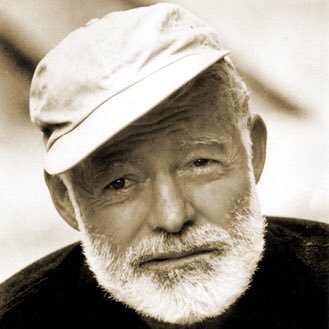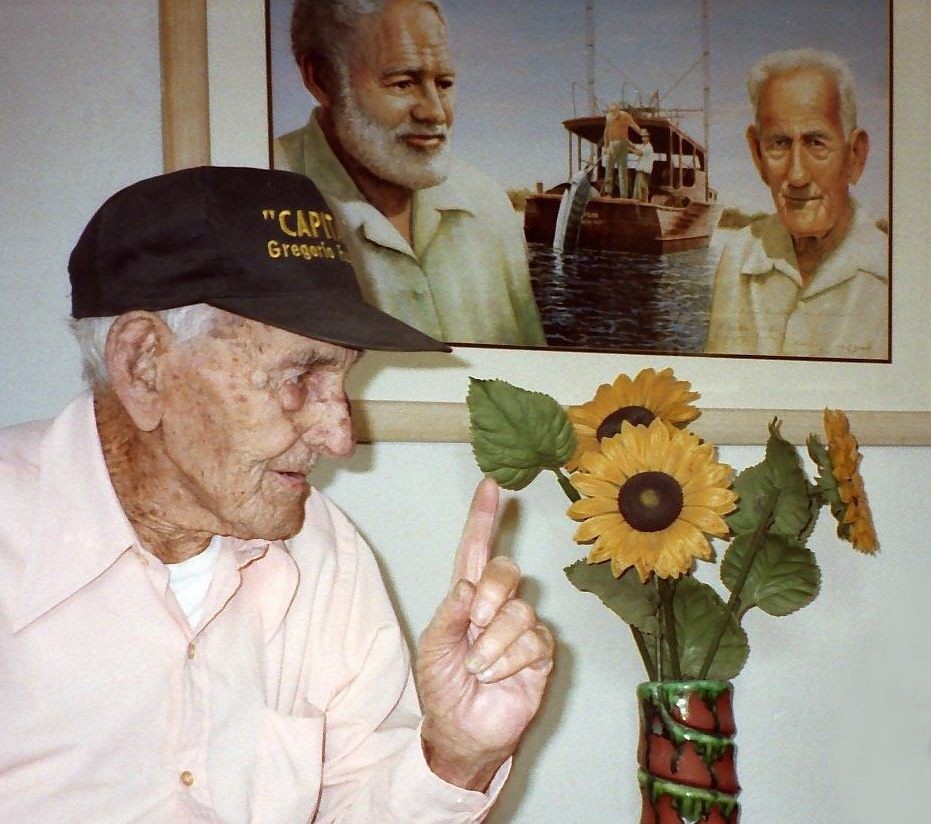The Old Man and the Sea Summary
7 min read ⌚
 There’s something biblical and religious in “The Old Man and the Sea,” a story about a Cuban fisherman, a 5.5-meter-long marlin, and few hungry sharks.
There’s something biblical and religious in “The Old Man and the Sea,” a story about a Cuban fisherman, a 5.5-meter-long marlin, and few hungry sharks.
And if you know Ernest Hemingway – that’s more than a recommendation.
Read our summary to find out why.
Who Should Read “The Old Man and the Sea”? And Why?
“The Old Man and the Sea” won Ernest Hemingway both a Pulitzer Prize in 1953 and a Nobel Prize a year later.
It also won the hearts of millions of people, becoming a bestseller and bringing the somewhat forgotten Hemingway back into the spotlight.
It’s a great story about man’s strength and determination in the face of defeat. It’s also an allegory which may function on at least two levels.
So, people who like fable-like stories such as William Faulkner’s “The Bear” or Herman Melville’s “Moby Dick” will certainly like “The Old Man and the Sea.”
And those who like just a good old story about a fisherman and his fish will never read a better book in their lives.
Ernest Hemingway Biography
Ernest Hemingway was one of the most acclaimed American writers in history and one of the most influential authors of the 20th century.
was one of the most acclaimed American writers in history and one of the most influential authors of the 20th century.
Described by “Time” magazine as “a globe-trotting expert on bullfights, booze, women, wars, big game hunting, deep sea fishing, and courage,” Hemingway is one of the few novelists Nassim Nicholas Taleb would approve: he rarely wrote about something he hadn’t experienced himself.
Meaning: he was severely wounded in World War I, worked as a journalist during the Spanish Civil War, was present at both D-Day and the liberation of Paris, went safari-hunting in Africa, survived two fatal plane crashes, and ended his life by shooting himself in the head in 1961.
In the meantime, he wrote numerous short stories, seven celebrated novels and a memoir considered one of the best in history.
He also won a Pulitzer and a Nobel Prize – both (mainly) for “The Old Man and the Sea.”
Plot
Boy, we like book titles that tell you what the book is about right off the bat!
Now, don’t get us wrong:
From time to time, we too would kit to read a title or two that make you think what a book could possibly be about even after finishing it.
(Here’s looking at you, Philip K. Dick!)
But isn’t it nice when some 20th-century author cares less about the first page than about the pages after?
In other words: no ruses, no cheap marketing tricks! Just saying it all from the cover – plain and straightforward!
The way the great ones in the old days did.
You don’t need to be an Einstein to know that “Hamlet” is a book about Hamlet, or that “Don Quixote” is a novel about Don Quixote.
Our point being:
Hemingway’s “The Old Man and the Sea” is about nothing else but an old man and the sea.
But Hemingway was like that: he wanted to use neither fancy nor too many words to say something he could say with less and ordinary, everyday words.
He also didn’t like to say that much at all, inventing a way of writing he named “The Iceberg Theory” (yeah, he first proposed that comparison!) which is based on the idea that writing should be about not saying the most important things.
Or, in the words of Hemingway himself: “you could omit anything if you knew that you omitted and the omitted part would strengthen the story and make people feel something more than they understood.”
In a nutshell: stories are for humans, but symbols are for suckers!
But, wait a minute!
Aren’t symbols the whole point of literature? And, correct me if I’m wrong, but isn’t “The Old Man and the Sea” celebrated precisely because of what it symbolizes?
Well, not according to Hemingway, it isn’t!
“No good book has ever been written that has in it symbols arrived at beforehand and stuck in,” says Hemingway. “That kind of symbol sticks out like raisins in raisin bread. Raisin bread is all right, but plain bread is better.”
And he goes on, referencing the book of our interest:
“I tried to make a real old man, a real boy, a real sea and a real fish and real sharks. But if I made them good and true enough, they would mean many things. The hardest thing is to make something really true and sometimes truer than true.”
If you want that translated into a pop-culture reference, please think of our favorite libertarian Ron Swanson and his analysis of metaphors and “Moby Dick”!
Well, in that scenario, Hemingway is Ron (add a beard, and the similarity is uncanny) and literary critics reading him are Chris Traeger.
We’re not joking!
There’s so little literary fiction in Hemingway that even the old man of this story was an actual person.
Ladies and gentlemen, meet Mr. Gregorio Fuentes – as a pretty old, old man:

In Hemingway’s story Gregorio is called Santiago, and he is a “thin and gaunt” Cuban “with deep wrinkles in the back of his neck.”
Also, he hasn’t caught a fish for almost three months – 84 days to be exact.
Talking about unlucky streaks, ha!
Needless to point out, this doesn’t go down well with the community. Especially not with the parents of Manolin, the boy who is his apprentice.
At their order, about a month and a half ago, the boy has joined a boat which actually catches fish. But he is still endeared with Santiago, feeling sorry for him and his “salao, which is the worst form of unlucky.”
So, he visits him every night, hauling Santiago’s fishing gear and preparing him a meal or two.
In other news: Manolin may actually know where Joe DiMaggio has gone since that’s basically all he talks about with Santiago.
Now, at the beginning of our story, Santi – can we call him Santi? – informs Manolin that he intends to go far out into the Gulf Stream hoping to put an end to his streak.
Day 85.
Noon.
Santiago notices that his bait is taken by a big fish.
How does he know it’s a big one?
Well, basically, because instead of him hauling it in, the fish is the one who pulls him out of his skiff.
Santiago is an experienced fisherman, so there’s no reason not to believe him that he’s fighting a marlin.
If you don’t know what a marlin is, it suffices to say that, on average, it’s about twice to three times as long as you and about five times as weighty.
(Notice how we don’t even care about how tall and weighty you are.)
If you can’t suppose what kind of an apocalyptic struggle happens during the next three days, please be our guest and watch at least parts of this wonderful, wonderful Academy Award-winning Russian (don’t worry: it’s in English) animated feature from 1999:
You’d expect Santiago to hate his enemy.
But, no!
He calls the marlin his “brother” and he doesn’t even care if he loses:
You are killing me, fish, the old man thought. But you have a right to. Never have I seen a greater, or more beautiful, or a calmer or more noble thing than you, brother. Come on and kill me. I do not care who kills who.
Fortunately for us – who have grown to adore Santi – it’s the marlin which loses in the end: on the third day of their struggle, Santiago stabs the fish with a harpoon.
Afterward, he straps it to the side of his boat and starts thinking about how many people such a beast will feed.
And also – about how much money the marlin would bring him.
The Old Man and the Sea Epilogue
But you know who doesn’t think in terms of money?
Sharks.
Sharks don’t.
Their currency is blood – and that’s exactly what the killed marlin oozes at this point.
So, Santiago now has to deal with the sharks trying to eat his marlin.
He kills one of them with his harpoon – but loses the weapon in the process.
Unbroken – ha, see what we did there? – he straps a knife to one of the oars and kills four more. But there are just too many sharks and too little Santiagos on this planet.
So, by the end of the day, bones are all that remain from the marlin, Santi’s catch.
Santiago reaches the shore, and he goes straight to his shack, leaving the fish skeleton behind him.
The next morning, a group of fishermen sees it. One of them measures the marlin to be 18 feet long from nose to tail. Others mistake the beast for a shark.
Manolin brings Santiago newspaper and a coffee and promises him to fish with him once again.
Santiago falls asleep and dreams about the lions from his youth.
But that’s another story by Hemingway altogether.
Wait a minute!
Could “The Old Man and the Sea,” Hemingway’s last work – just like Shakespeare’s “The Tempest” – be an allegorical account of his literary career in addition to being a story about life’s victories and defeats?
No, man – it’s a plain old story about a boy, a Cuban fisherman and a marlin.
And sharks.
Once again you’re thinking in terms of symbols, aren’t you?
Like this summary? We’d like to invite you to download our free 12 min app, for more amazing summaries and audiobooks.
“The Old Man and the Sea PDF Quotes”
Every day is a new day. It is better to be lucky. But I would rather be exact. Then when luck comes you are ready. Share on X But man is not made for defeat,’ he said. ‘A man can be destroyed but not defeated.’ Share on X Let him think that I am more man than I am and I will be so. Share on X Now is no time to think of what you do not have. Think of what you can do with that there is. Share on X Most people were heartless about turtles because a turtle’s heart will beat for hours after it has been cut up and butchered. But the old man thought, I have such a heart too. Share on XOur Critical Review
Ernest Hemingway was one of the most celebrated novelists and short story writers of the 20th century. And behind him, he left many great works which are considered classics to this day.
However, when he won the Nobel Prize for Literature in 1954, the Committee referred explicitly to this, his last major work of fiction published in his lifetime, saying that it awards Hemingway the Nobel “for his mastery of the art of narrative, most recently demonstrated in ‘The Old Man and the Sea,’ and for the influence that he has exerted on contemporary style.”
Hemingway himself thought it was “the best [he could] write ever for all of [his] life.”
We humbly share the opinion.
Emir is the Head of Marketing at 12min. In his spare time, he loves to meditate and play soccer.







